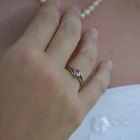
Comstock/Comstock/Getty Images
Likely inspired by the Ancient Egyptian belief that a nerve or vein in the ring finger connects directly to the heart, wearing jewelry on this finger usually signifies commitment or attachment. However, a man can send different messages depending on the type of ring and whether he places it on his left or right hand.
Wedding Bands

BananaStock/BananaStock/Getty Images
Most married men didn't wear wedding bands until jewelry companies began marketing the rings in the first half of the 20th century. During World War II, soldiers fighting overseas often chose to wear wedding bands to remind them of loved ones, and they have remained popular ever since. Following marriage, a man will usually wear his ring as part of his everyday attire. Removing it in social settings may be viewed as inviting infidelity or signifying trouble in his marriage. A widower may decide for himself whether to continue wearing his wedding band, remove it, or place it on another finger instead (customarily the right ring finger). It is not appropriate for a divorced man to wear his wedding band.
Engagement Rings
Whether or how to wear a ring following his engagement is a decision that a man should make together with his partner. Because ring finger etiquette varies across cultures and religions, their respective backgrounds may influence this choice. Brazilian men, for example, usually wear the wedding band on the right ring finger after becoming engaged and move it to the left ring finger once married. In Eastern Europe, by contrast, it is common for a man to wear his wedding band on the right ring finger.
Class Rings, Championship Rings, and Fraternity Rings

Hemera Technologies/Photos.com/Getty Images
To avoid confusion with the wedding band, proper etiquette demands that most other rings -- including class rings, championship rings, and fraternity rings -- be worn on the right ring finger. (One notable exception is United States service academy class rings, which graduates wear on the left.) Additional etiquette depends on the type of ring: a championship ring may not be appropriate in all social settings, and a high school class ring should not be worn long after graduation, but it is acceptable for a man to continue to wear a college or university class ring. These rings, which often include engraving and real or synthetic stones, may be large and ornate.
Signet Rings

Creatas/Creatas/Getty Images
Signet rings carry the wearer's initials or family coat of arms and historically served to sign and seal documents. Etiquette for wearing signet rings varies by country: in English-speaking countries, it is customary for a man to wear his signet ring on the little finger of his non-dominant hand, whereas a signet ring should be worn on the left ring finger in France and the right ring finger in Switzerland. Certain offices and titles also have specific etiquette associated with the signet ring; it is appropriate for the Catholic faithful, for instance, to kneel and kiss the ring of high-ranking church officials, including the pope.
Promise Rings
Wearing a promise ring on the left ring finger like a wedding band or engagement ring implies that a couple intends to become engaged in the future. Since the 1990s, purity rings - a type of promise ring for individuals practicing sexual abstinence until marriage- have increased in popularity with both men and women affiliated with certain Christian traditions. Men who choose to wear a purity ring will generally put it on the left ring finger until they marry. Rings signifying other types of promises may be placed on other fingers to avoid misinterpretation.
Related Articles

What Is the Meaning of a Ring on the ...

The Meaning of Exchanging Wedding Rings

Why Does the Wedding Ring Go on the 4th ...

Etiquette of Signet Rings

What Finger to Wear a Promise Ring On

Does the Wedding or Engagement Ring go ...

Why Do Men Wear Wedding Bands on Their ...

What Is a Journey Ring?

On Which Finger Do You Wear an Eternity ...

Reasons to Get a Nose Ring

Safety Issues with Tungsten Wedding ...

About Christian Men Wearing Earrings

Types of Masonic Rings

Why Do People Wear a Wedding Ring on ...

Pros and Cons of Marrying

The Difference Between a Promise Ring & ...

The Meaning of Wedding Bands

Reasons to Divorce Your Husband

What Can You Wear for a Hindu ...

The Proper Way to Wear a Wedding ...
References
Writer Bio
Amanda Parsons began working as a writer in 2010, with a professional background in elected government. She holds a Bachelor of Arts in political science and French and a Master of Arts in geography. Parsons is currently pursuing a PhD in geography. Her academic research includes governance, development and political ecology.
Photo Credits
Comstock/Comstock/Getty Images